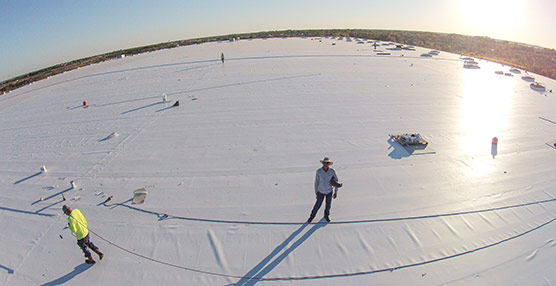FIVE SIGNS THAT YOUR ROOF IS IN NEED OF A CHECKUP

As a successful business owner, not much gets by you. But one of the most important and most overlooked things is the roof over your head. “If it ain’t broke, don’t fix it”, as the saying goes. But a failing roof is often not obvious, and small problems can easily turn into large, expensive problems. Fortunately, there are some things you can look for.
Your Roof Is Old
You should have a professional commercial roofing company inspect your roof annually. Small problems can be spotted before they become big problems. An established maintenance program can extend the longevity of your roof.
Depending upon the system, however, each roof reaches a point where old age makes catastrophic failure inevitable. By anticipating this phase, and by working with a professional commercial roofer, you can plan and budget for a roof replacement on your schedule.
Your Roof Sags
When you notice pools of water that never seem to dry from the surface, this is called “ponding”. Roofs are designed to drain water off the roof before it has a chance to do any damage. Standing water is the worst enemy of any roof, no matter its age. Ponding may indicate structural integrity to the decking, or it may be caused by moisture seeping into and swelling the insulation below the membrane. Once your roof begins to sag, it’s only a matter of time before irreversible damage occurs.
As soon as you suspect a problem, call in a commercial roofer. And of course, a maintenance program that includes routine inspections will help catch this problem at an early state.
You Notice Shingles on the Ground
If your roof has a composition shingle component, pay special attention to shingles laying on the ground. If the asphalt seals have broken over time, high winds and heavy rains may cause them to fall off, leaving the interior of your roof exposed to the elements. Once excessive moisture builds up inside your roof, your problems increase exponentially. When you see those shingles on the ground or in your gutters, do not delay calling your roofing partner to prevent further damage
You Notice Missing Flashing
Flashing is typically the metal coverings on the parapets and roof edges of your building. A study by the insurance industry found that 75% of all losses are related to roof failures, and 59% of those losses were directly attributable to failure at the perimeter. Poorly designed perimeter flashing along with high winds can tear off your flashing, pull up the membrane, and expose your roof to further damage. Addressed quickly, further damage can be easily mitigated.
Your Roof Is Not Insulating Like It Used To
Insulation is one of the most important jobs of your roof. Each year, building codes call for greater insulation capabilities for new and replacement roofs. But insulation can fail with age, whether from hail damage that may damage the insulation without puncturing the membrane, or with the introduction of moisture into the insulation, degrading its thermal properties.
One way you may notice this degradation is an increase in your utility bills year over year. Annual inspections and a maintenance contract mean that potential problems can be nipped in the bud. And for older roofs, an energy analysis can show you how a new roof can often pay for itself in reduced energy expenditures.
The Bottom Line
Early detection is the solution. Whether we are talking about changing the oil in your car, getting an annual physical from your doctor, or having your commercial roofing partner inspect your roof each year, small problems can be prevented from turning into larger problems.
- When you notice any one of these five signs, take immediate action.
- Have an already established relationship with a commercial roofing contractor who can notice the changes to your roof.
- A maintenance contract is a proven way to extend the life of your roofing system. Most manufacturers will void their warranties if you do not take this basic step, and some manufacturers will even reward you by extending their warranty if you do have your roof professionally maintained.
- Plan so that when the day comes, you can replace your roof on your terms and your budget


